
A Whirlwind Tour of Lucknow
By Mridula Dwivedi

I had pretty mixed feelings as my train was entering Lucknow. A badly upset stomach was not helping either.
All through the six hours of my train journey by Lucknow Shatabdi Express from Delhi, I had to starve as my stomach was growling and grumbling in spite of the medicine I had taken.
I had gone to Lucknow to attend an academic conference on tourism organized by one of the big management institutes in India and I was very scared of getting ill there.
When I got down at the Charbagh Railway Station, Lucknow, I was surrounded by people inquiring if I needed a pre-paid taxi.
If you have been to India you would know these people quote many times over the normal fare. But not this time, it seems only pre-paid autos are allowed inside the station premises and they operate on fixed prices.
A Tryst with the Past
The city has been part of my life since childhood as one of my aunts with her family live there.
I have spent (part of) many school summer vacations there enjoying to the hilt. Later when I was doing my Ph.D nearby in the city of Kanpur, her house was again my home on so many weekends.
I have also stayed for a brief period at the Sports Hostel at K.D. Singh Babu Stadium when I was in school. I was one of the two people to be selected in the entire state to be trained there. The catch was that I was good at studies too.
So, after six months or so I decided that my studies were getting ruined completely and I did not wish to stay. My school back home, in a rare move, re-admitted me just before the final exams.
While the auto-rickshaw was negotiating all those familiar lanes, where we used to go for cross-country running (must I say with the dreams of making it big in my eyes) I was wondering if I had lost myself long back in those lanes.
But even though the city is familiar to me, I never managed to explore it as a tourist! So, I was quite excited about the third day of the conference, which included a sightseeing tour of the city. I presented my paper on the first day and kept in reasonable health though I still had to keep starving intermittently.

On a Guided Tour
So twelve of us, on the third day of the conference, boarded an air-conditioned bus (temperatures soar in March in India) and met our tour guide. Lucknow is known for its politeness and the guide was an epitome of it. But little did we know what was in store for us later.
He told us a little about the city which was known as Avadh in the times gone by and was ruled by colorful kings and noblemen. Our first stop was the Bara (big) Imambara. Some of us had trains and planes to catch the same day and shopping was also included in the agenda.
There is a beautiful gate next to the Bara Imambara called Roomi Darwaza (door) and the entrance to the Imambara is also grand. It is said to be built around 1783, commissioned by the ruler Asaf-Ud-Daula in the time of severe famine. The objective was to provide employment and relief to the people.
There are many parts within the complex. As you enter on your right-hand side is a grand mosque, and the main structure has a huge hall that has no supporting pillars.

There is a labyrinth too within the main building and it is strongly advised not to enter it without a guide.
Then as you get out of the labyrinth you will find a bowli (underground water tank) with many interesting architectural features.
Rushed Tour
If my writing sounds rushed to you, so was my tour. The guide would literally run from one structure to another and so would some of us.
We tried to form a breakaway group walking at a more leisurely pace but then we gave up that strategy quickly inside the labyrinth; we did not wish to be left behind inside those dark alleys.
I also sensibly put my DSLR to auto mode as there was no time to compose pictures with any detail. Needless to say, I would be the last person coming out of these places at every stop except for shopping.
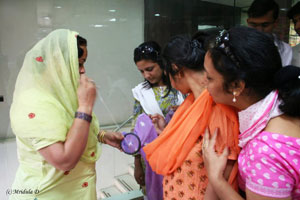
Shopping for Chikan Work
The next stop for us was a shop at the Bazaar at Chowk. Lucknow is famous for a particular kind of embroidery called ‘chikan’ work.
So, all the ladies in the group had a gala time inside this air-conditioned shop looking at stuff, the guys were scratching their heads for most of the time and I was clicking pictures of the colorful materials to my heart’s content.
I also managed to buy one dress for myself in between. The choice was easy because the members in our group had excellent taste and I just went by their choice!

After a very long time (or so it felt to me) we emerged out of the shop to head to the Chota (small) Imambara.
Chota Imambara and Residency
Chota Imambara is another beautiful example of Islamic architecture. It shares the same history as the Bara Imambara; this was also built in the time of famine. It has two mosques on each side and a water stream in the middle.
There was a beautiful white horse roaming within the premises, though of course, he kept a huge distance from us!
The Imambaras are places of worship. The Chota Imambara houses many beautiful chandeliers inside its main hall along with other objects of religious importance.
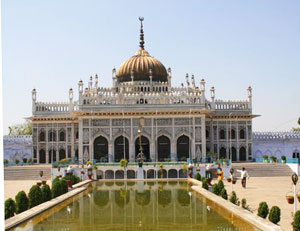
Our next stop was the ruins of the British Residency. Nawab Saadat Ali Khan started the construction around 1800 AD to house the British officials of the Lucknow.
The place saw heavy fighting during the first Indian struggle for independence in 1857 and the place is preserved in the ruined condition. There are signs of heavy artillery shelling all over the place.
The banquet hall and the house surgeon’s residence were the structures that I could explore in some detail.
There is a museum inside the place documenting the struggle through photographs, lithographs, and artifacts. You will be asked to deposit all your belongings to a locker before you are allowed inside the museum. There is an entry fee for all the monuments.
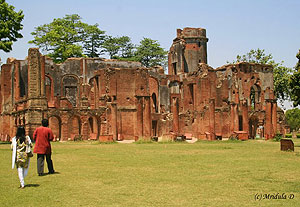
I was the last person to come out of the museum and the photographs I saw of the residency before the fighting took place were beautiful.
The residency is huge but then again I could explore only a small part of it due to the rushed way we were going about this trip.
La Martiniere College
We visited La Martiniere College next. The college dates back to 1845 and it still functions as an educational institute for both boys and girls. It has imposing architecture and was founded by a Frenchman Claude Martin.
Right next to the grand main building (Constance Hall) is a tall pillar, know as the Laat, beyond which the river Gomti flows.

While we were entering through the gates, there was a notice saying the institute had not a single seat vacant and if a vacancy opened later, they would announce it to the public!
It is tough to find a good school with vacancy in India. The schoolboys played an important role in the defense of the Residency during 1857 but I got to know this from reading Wikipedia rather than from our guide.
Saying Goodbye to Lucknow
The sun was high in the sky by this time, and our group wished to do another round of shopping. So it was back to another shop selling chikan-work dresses and material.
Some of us ventured to the main market, Hazratgang, had chaat (local snacks in North India that are very tasty), and then it was time to head back to the conference campus. The next day, I was heading back to Delhi.
There are many other places at Lucknow to be visited and I wish we had more time and done it properly.

The group consensus was that Indian guides consider sightseeing as a chore, to be done and gotten over within minimum time. But then many of us were in a hurry too.
The short glimpse that I have caught of the city makes me want to explore it more at a leisurely pace.
I have been thinking hard about my feeling of loss when I revisited the lanes where I used to run once. I think whatever I lost because of not being able to pursue sports professionally, I have gained much more through my travels and academics.
Maybe when I go back next I will be able to face those lanes squarely and serenely.
And I had a wonderful conference too.
- India: Romancing the Chandratal Lake - October 14, 2015
- India: Viewing Tigers Up Close - March 17, 2014
- Kipling’s Bundi: Peacocks and Palaces in Rajasthan - August 13, 2012




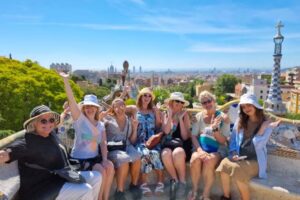
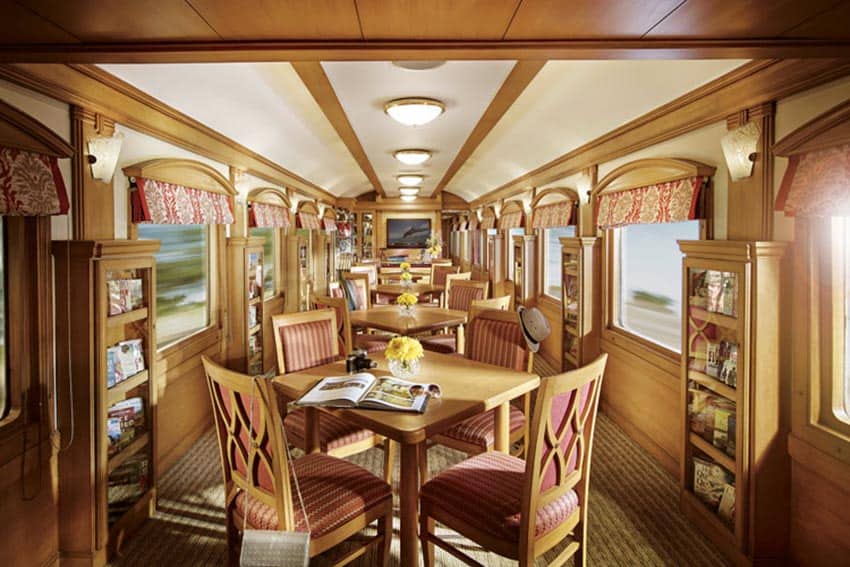
Awesome! Thanks for sharing this post. We know that Lucknow city itself is famous for many aspects of its rich culture, from music, poetry, travel, and food etc.This post is very nice.Thanks for sharing this interesting post with us.
Very good information about Lucknow tourist places. picture also good thanks for sharing this Beautiful blog…!!